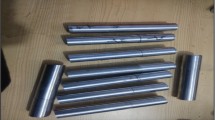Abstract
This work studies the machinability of EN8 steel by employing Taguchi method, analysis of variance (ANOVA) and genetic algorithm (GA). The CNC turning experiments are planned and conducted as per L27 orthogonal array and polynomial models for surface roughness and circularity error of EN8 steel shaft are developed. Reliability of polynomial models and significance of turning parameters are tested using ANOVA. The polynomial models are integrated with GA as fitness function to find the optimal turning conditions which has to minimize the surface roughness and circularity error as well. Further, the optimum turning conditions obtained from GA are validated by confirmation experiments. From the results, it was noted that turning conditions obtained from GA correlate well with experimental results. This shows that Taguchi method, ANOVA and GA can be used for minimizing the surface roughness and circularity error in the turning of EN8 steel.
Access this chapter
Tax calculation will be finalised at checkout
Purchases are for personal use only
Similar content being viewed by others
References
Satheesh Kumar N, Shetty A, Shetty A, Ananth K, Shetty H (2012) Effect of spindle speed and feed rate on surface roughness of carbon steels in CNC turning. Procedia Eng 38:691–697
Sushil P, Sharma K, Kumar ES (2014) Optimization of surface roughness in CNC turning of mild steel (1018) using Taguchi method. Int J Eng Res Appl 3:2928–2932
Nikam KG, Kadam SS (2014) Optimization of surface roughness of EN8 steel by changing cutting parameters and insert geometry in turning process. Int J Sci Res 3:1331–1335
Shet GT, Lashmana Swamy N, Somashekar H (2014) Optimization of surface roughness parameters in turning EN1A steel on a CNC lathe without coolant. Int J Eng Res Technol 3:1648–1657
Krishna DG, Kumar MV (2017) Taguchi analysis on surface roughness in turning OHNS high carbon steel with DNMG carbide insert. Int J Innov Res Sci Technol 4:1–7
Gugulothu B, Kumsa DK, Kassa MB (2017) Effect of process parameters on MRR and surface roughness in turning process of EN8. Mater Today Proc (Published in Online)
Sahu NK, Andhare AB (2019) Multiobjective optimization for improving machinability of Ti-6Al-4V using RSM and advanced algorithms. J Comput Des Eng 6:1–12
Babbar A, Prakash C, Singh S, Gupta MK, Mia M, Pruncu CI (2020) Application of hybrid nature-inspired algorithm: single and bi-objective constrained optimization of magnetic abrasive finishing process parameters. J Mater Res Technol 9:7961–7974
Mathews PG (2005) Design of experiments with MINITAB. ASQ Quality Press, Milwaukee, Wisconsin
Anand K, Elangovan S (2017) Optimizing the ultrasonic inserting parameters to achieve maximum pull-out strength using response surface methodology and genetic algorithm integration technique. Measurement 99:145–154
Krishnaiah K, Shahabudeen P (2012) Applied design of experiments and Taguchi method. PHI Learning Private Limited, New Delhi
Author information
Authors and Affiliations
Corresponding author
Editor information
Editors and Affiliations
Rights and permissions
Copyright information
© 2023 The Author(s), under exclusive license to Springer Nature Singapore Pte Ltd.
About this paper
Cite this paper
Anand, K., Pratheesh Kumar, S., Hari Chealvan, S. (2023). Investigation on Machinability of EN8 Steel Through Taguchi Method, ANOVA and Genetic Algorithm. In: Natarajan, E., Vinodh, S., Rajkumar, V. (eds) Materials, Design and Manufacturing for Sustainable Environment. Lecture Notes in Mechanical Engineering. Springer, Singapore. https://doi.org/10.1007/978-981-19-3053-9_15
Download citation
DOI: https://doi.org/10.1007/978-981-19-3053-9_15
Published:
Publisher Name: Springer, Singapore
Print ISBN: 978-981-19-3052-2
Online ISBN: 978-981-19-3053-9
eBook Packages: EngineeringEngineering (R0)




